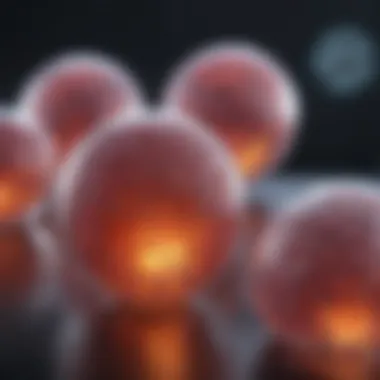Stem Cell Complications: Risks and Challenges Explained


Intro
Stem cell therapies present immense promise in regenerative medicine and the treatment of various diseases. However, as researchers and practitioners delve into this complex field, it becomes increasingly clear that alongside their potential, stem cell therapies also bring significant complications and risks. A thorough understanding of these complications is essential for anyone involved in stem cell research or clinical applications.
Complications can arise from different types of stem cell treatments, including autologous and allogeneic procedures. The source of stem cells—whether derived from bone marrow, adipose tissue, or pluripotent sources—also plays a critical role in determining the nature of the risks involved. Patients receiving stem cell therapies might experience adverse effects related to immune rejection, tumor formation, or systemic complications.
By focusing on both these known complications and the mechanisms that underlie them, this article aims to illuminate the intricate challenges associated with stem cell therapies. As we unravel the implications of various types of complications, we also emphasize the necessity for vigilant methodologies and ethical considerations in this ever-evolving field.
Key Findings
Summary of the main results
Research conducted in the realm of stem cell therapies has highlighted a range of complications that can arise during treatment. Some of the key findings include:
- Immune Reactions: Allogeneic stem cell transplants often lead to immune responses which can cause graft-versus-host disease (GVHD).
- Tumorigenesis: There is a risk of tumor formation, particularly with pluripotent stem cells. Tumors may develop due to uncontrolled cellular growth post-therapy.
- Infection: The immunocompromised state of patients post-transplant makes them susceptible to various infections.
- Functional Impairments: Inadequate integration of stem cells into the host tissue can lead to functional impairments.
"Continuous research is vital to understand the long-term complications associated with stem cell therapies to increase their efficacy and safety."
Significance of findings within the scientific community
The findings surrounding stem cell complications are critical not only for improving therapeutic outcomes but also for guiding future research. The acknowledgment of risks like GVHD and tumorigenesis underlines the importance of patient selection and treatment planning. It invites a reevaluation of current practices within the scientific community and promotes a more cautious approach to clinical applications.
Implications of the Research
Applications of findings in real-world scenarios
The knowledge gathered from recent studies signifies a transformational shift in how stem cell therapies are approached in healthcare settings. Practitioners can leverage this information to:
- Implement better patient screening processes to predict and mitigate risks.
- Develop protocols that monitor for complications like GVHD and infections closely.
- Incorporate multidisciplinary care teams to manage complications promptly, ensuring patient safety.
Potential impact on future research directions
As the landscape of stem cell research advances, understanding complications can critically influence future studies. Researchers are likely to focus on:
- Developing safer stem cell lines with reduced tumorigenic potential.
- Investigating bioengineering approaches to improve stem cell integration into host tissues.
- Exploring new immunosuppressive therapies that can limit adverse immune responses without compromising patient safety.
These avenues of research underscore the pressing need for a careful and informed approach to the deployment of stem cell therapies.
Intro to Stem Cell Therapies
Stem cell therapies hold a significant place in modern medicine. Their potential to treat a variety of diseases and injuries makes them precious in research and clinical settings. Understanding stem cell therapies is essential for grasping the overall challenges and complications associated with their use. This section will provide a foundational knowledge of stem cells, their history, and current applications.
Definition and Overview of Stem Cells
Stem cells are unique cells capable of developing into many different cell types. They serve as a kind of internal repair system for the body. In simple terms, they can differentiate into specialized cells that perform specific functions. There are mainly two types of stem cells: embryonic and adult. Embryonic stem cells are derived from human embryos. They possess greater potential to develop into any cell type, making them versatile for research. On the other hand, adult stem cells are found in various tissues and are more specialized, with limited differentiation capabilities. Their primary role is to maintain and repair the tissue where they reside.
History of Stem Cell Research
The historical perspective of stem cell research is crucial to understanding its development. Research began in the early 20th century, with scientists identifying the existence of blood-forming stem cells. By the late 1990s, the attention shifted to human embryonic stem cells. A major breakthrough came in 1998, when researchers at the University of Wisconsin successfully isolated and cultured human embryonic stem cells. This event marked the foundation for extensive studies into their therapeutic potential. Over the years, various breakthroughs have led to the advancement of stem cell research. However, ethical debates also emerged, creating a dichotomy in the field that persists today.


Current Applications of Stem Cells
Today, stem cell therapies are used in numerous applications. They play an important role in treating conditions like leukemia, lymphoma, and several genetic disorders. Hematopoietic stem cell transplantation is a common treatment for blood-related diseases. Furthermore, researchers explore the use of stem cells in regenerative medicine. This includes attempts to restore damaged tissues in conditions such as spinal cord injuries and heart disease. Despite these advancements, the field faces various challenges. Complications arising from these therapies need to be critically evaluated to ensure safe use.
"The journey of stem cell research has been marked by a blend of hope, promise, and ethical considerations."
Understanding stem cell therapies provides essential insights into their potential and associated complications, illustrating the complex landscape of scientific progress and human impact.
Complications Associated with Stem Cell Use
Understanding the complications associated with stem cell use is critical in the context of this article. Stem cell therapies, while promising, often come with potential risks that must be addressed. Failing to consider these complications can lead to detrimental outcomes in clinical applications. Therefore, reviewing the benefits and considerations regarding complications serves as a foundation for further discussion. Throughout this section, we delve into various types of complications and their prevalence, which are essential for professionals in the field to comprehend fully.
Types of Complications
Acute Complications
Acute complications are immediate adverse effects that can manifest shortly after stem cell therapy. These complications can include reactions such as fever or infusion-related symptoms. The key characteristic of acute complications is their rapid onset. This characteristic makes understanding them particularly vital in patient monitoring and management.
Many healthcare providers regard acute complications as important markers because they can indicate underlying issues early in treatment. For example, recognizing a fever during the initial days post-procedure may require immediate investigation.
However, these complications can also create challenges in long-term patient care, as they might lead to premature discontinuation of potentially beneficial therapies. Therefore, while acute complications can be concerning, they also provide a window for risk assessment in stem cell therapy protocols.
Chronic Complications
Chronic complications emerge days, weeks, or even months after the administration of stem cells. These issues can include long-term effects such as graft-versus-host disease (GVHD) or organ dysfunction. The critical aspect of chronic complications lies in their duration and impact on the patient's quality of life over an extended period.
These complications are of high relevance to this article because they often dictate ongoing patient management strategies. Chronic issues necessitate continuous medical review and may require long-term pharmacological intervention.
Patients can experience significant psychological burdens as a result of chronic complications. This aspect highlights the need for integrated care approaches. The ongoing nature of chronic complications poses an important challenge while simultaneously underlining the complexities involved in stem cell treatments.
Late Complications
Late complications arise much later in the treatment timeline, often years after stem cell interventions. Examples include secondary malignancies or late-onset autoimmune disorders. The uniqueness of late complications is both their delayed appearance and their often subtle clinical manifestations.
These complications contribute significantly to the understanding of the long-term safety and efficacy of stem cell therapies. They can represent a paradigm shift in how researchers view intervention results over an extended duration. The identification of late complications requires robust long-term follow-up studies to ensure patient safety beyond the initial treatment period. Navigating the implications of these complications proves crucial for ensuring the overall success of stem cell applications.
Prevalence of Complications
The prevalence of complications associated with stem cell therapies adds another layer of importance to this discussion. Complications can vary widely based on several factors, including the type of stem cells used, the condition being treated, and the patient's individual physiology.
Statistical analyses of clinical trials indicate that acute complications can occur in approximately 15-30% of stem cell patients, while chronic complications are reported in 20-50% of cases over time. Late complications, although less frequently studied, have shown concerning rates of secondary malignancies ranging from 2-10% in some patient cohorts.
Understanding these prevalence rates is fundamental for practitioners to set realistic expectations and to guide patient discussions effectively.
Evaluating the risk of complications aids in informed decision-making, enhancing patient trust in therapeutic processes. Furthermore, this data highlights the necessity for ongoing research into safer stem cell therapies and improved monitoring strategies.
Mechanisms Behind Stem Cell Complications
Understanding the mechanisms behind stem cell complications is crucial for predicting and addressing potential risks associated with these therapies. Each mechanism can lead to varying degrees of adverse effects on patients. Dissecting these factors not only aids in enhancing clinical outcomes but also promotes safer application of stem cell treatments. The importance of this topic encompasses several elements, including the understanding of immune behaviors, genetic responses, and the potential for infection.
Immune Reactions


Immune reactions present a significant concern in stem cell therapies. When stem cells are introduced into a patient's body, the immune system may identify these cells as foreign entities. This misinterpretation can lead to an immune response that might cause acute rejection or delayed complications. One potential outcome is the activation of T cells, which can lead to what is termed graft-versus-host disease (GVHD). This condition can severely affect patients, causing inflammation and damage to healthy tissues.
Monitoring immune reactions is essential. Physicians often need to implement immunosuppressive therapies, which aim to reduce the likelihood of a rejection. However, this can put patients at risk for infections and other complications. Recognizing the differences between acute and chronic immune responses can aid in tailoring prevention strategies.
Genetic Instability and Tumorigenesis
Genetic instability among transplanted stem cells constitutes another fundamental mechanism of complications. Stem cells possess the ability to divide and differentiate into various cell types. However, this inherent characteristic comes with the risk of unforeseen mutations. Genetic alterations may arise either from the manipulation processes in the laboratory or from changes in the in vivo environment once the cells are introduced into the body. These mutations can potentially lead to tumorigenesis, which is one of the most serious complications associated with stem cell therapies.
Evaluating genetic integrity before and after stem cell procedures is vital. Various techniques, such as next-generation sequencing, can help understand genetic profiles and guide treatment decisions. Focusing on minimizing genetic instability not only improves patient safety but also encourages the development of standardized protocols for researching and utilizing stem cells.
Infection Risks
Infection is a concern that cannot be overlooked when discussing stem cell complications. The processes involved in stem cell collection, storage, and implantation can expose patients to a range of infectious agents. Whether through surgical procedures or handling in a lab environment, there are multiple points where contamination can occur. Moreover, patients undergoing stem cell therapy often have compromised immune systems due to preconditioning regimens, making them more susceptible to infections.
Preventing infections involves adhering to strictly regulated protocols during cell procurement and transplantation. Effective sterilization techniques and monitoring protocols must be developed and implemented. Additionally, education regarding hygiene, both in healthcare settings and after coming home, is necessary for patients to understand the risks they might encounter.
"Understanding these complications is fundamental to develop better treatment protocols and patient outcomes in this evolving field."
Analyzing these mechanisms is crucial in forming a comprehensive understanding of potential challenges. As research continues to unfold in the realm of stem cell therapies, addressing these complications will remain a pivotal focus. Further investigations into each mechanism can foster more targeted advancements and safer treatment options.
Case Studies of Stem Cell Complications
Case studies serve as essential elements in understanding the broader implications of stem cell therapies. They provide real-life examples that highlight outcomes of such treatments, offering insights into both successes and failures. The analysis of these cases not only sheds light on the complications that may arise but also emphasizes the importance of rigorous clinical protocols. Through these studies, researchers and practitioners can better grasp the nuances of patient responses, which can significantly influence treatment strategies and patient safety.
Personalized medicine benefits immensely from case studies, as they illustrate how individual circumstances may lead to different outcomes. This approach fosters a deeper understanding of the biological and environmental factors that contribute to stem cell complications. It also informs regulatory bodies about the practical outcomes of therapies, guiding best practices in the field.
Moreover, these documented instances enrich the clinical knowledge base, making them valuable for training and education among students, researchers, and healthcare professionals. The focus on practical application and learning from past experiences enhances the journey towards effective and safe stem cell treatments.
Examples from Clinical Trials
Clinical trials provide a structured environment for evaluating the safety and efficacy of stem cell therapies. Numerous instances have illustrated the potential risks associated with these treatments. For example, in some trials involving hematopoietic stem cell transplants, patients reported severe complications. These ranged from graft-versus-host disease to organ dysfunction. Such adverse events underscore the importance of preclinical assessments and continued monitoring throughout the study.
Another noteworthy example is the use of adipose-derived stem cells for treating orthopedic injuries. Clinical trials have shown variable outcomes. Some patients experience significant regeneration of tissue while others develop inflammatory responses that complicate recovery. These discrepancies are critical as they urge researchers to refine protocols and patient selection criteria.
Additionally, breakthrough trials aimed at neurological diseases have surfaced unique challenges. In one instance, patients undergoing stem cell injections for spinal cord injury experienced mobility improvements, but some also reported adverse events like increased spasticity. This complexity highlights the need for thorough evaluations in trial designs and the necessity for inclusion of detailed patient histories.
Longitudinal Studies on Stem Cell Patients
Longitudinal studies are vital in tracking the long-term effects of stem cell therapies. They allow researchers to observe how patients fare over time, providing invaluable data on both benefits and complications. For instance, one extensive longitudinal study monitored patients receiving mesenchymal stem cell infusions over several years. The results indicated a trend toward improvement in chronic conditions, yet there were instances of late-onset complications such as tumorigenicity in some subjects.
This data is crucial. It informs regulatory agencies and practitioners about the potential risks that may not be apparent in short-term studies. Researchers can identify patterns, making it easier to predict outcomes and tailor future approaches. Furthermore, such long-term observations can enhance patient counseling, as they provide a more comprehensive outlook on what individuals may expect during and after treatment.
Ultimately, the findings from longitudinal studies underscore the significance of continual assessment in the context of stem cell therapies. By analyzing patient outcomes over extended periods, healthcare providers can better manage potential complications and adjust treatment protocols accordingly.
Regulatory and Ethical Considerations
The landscape of stem cell therapy is complex, necessitating a careful examination of regulatory and ethical considerations. The importance of these elements cannot be overstated. Both frameworks guide research and clinical applications ensuring patient safety while promoting scientific advancements. Regulatory systems aim to manage the use of stem cells, addressing safety and efficacy. Ethical considerations focus on the moral implications of research practices, balancing innovation with respect for human dignity.
Current Regulatory Frameworks
Regulatory frameworks for stem cell therapies vary considerably across different countries. In the United States, the Food and Drug Administration (FDA) plays a crucial role in overseeing stem cell treatments. The FDA categorizes these therapies based on whether they are considered drugs or biological products, requiring significant clinical trials for approval.


In Europe, regulations are largely governed by the European Medicines Agency (EMA). They enforce stringent guidelines regarding the manufacture and distribution of stem cell products.
Common aspects of these frameworks include:
- Assessment of safety and efficacy: Before any therapy reaches patients, it must undergo rigorous testing.
- Monitoring post-market safety: Continual monitoring ensures that therapies remain safe once they are in general use.
- Transparency in clinical trials: Clinical trials must be registered, and the results reported to promote public trust.
This multi-faceted approach helps to prevent misuse or unapproved applications of stem cell therapies.
Ethical Implications of Stem Cell Research
Ethical considerations in stem cell research often arise from the sources of the stem cells and their potential uses. There is ongoing debate regarding the use of embryonic stem cells, which raises questions about the moral status of embryos. Researchers must navigate these sensitive topics carefully.
Key ethical concerns include:
- Informed consent: Participants in clinical trials must fully understand the risks and benefits.
- Equity in access: There is a risk that stem cell therapies may only be accessible to affluent populations, leading to inequalities.
- Long-term effects: The long-term risks associated with stem cell treatments are often unclear, necessitating thorough research and transparency.
Ensuring that ethical considerations are integrated into research practices is paramount for building public trust.
Regulatory and ethical frameworks are vital in shaping the future of stem cell therapies. They protect patients and promote responsible research.
Future Directions in Stem Cell Research
The exploration of stem cell therapies is an ever-evolving field. Researchers are continually seeking innovative solutions to address the challenges and complications that arise. This section discusses the importance of focusing on future directions in stem cell research. Understanding these future directions is crucial for enhancing the efficacy and safety of stem cell therapies. Moreover, it highlights the potential benefits that stem cell research holds for various medical applications.
Innovative Approaches to Mitigate Complications
Mitigating complications is essential for the success of stem cell treatments. New methods are required to reduce risks associated with immune reactions, genetic instability, and infections. Researchers are exploring several innovative strategies, including:
- Personalized Medicine: Tailoring treatments according to individual genetic profiles may help in reducing adverse effects. By understanding the recipient's immune system better, researchers can formulate treatments that are more compatible.
- Tissue Engineering: Developing artificial tissues that use stem cells can reduce the need for traditional stem cell transplants. This can minimize complications like rejection and infection.
- Controlled Differentiation: Establishing methods to control the differentiation of stem cells with precision may lead to safer applications. It can ensure that stem cells develop into the desired cell types without forming tumors.
These approaches could provide invaluable direction in addressing current complications, fostering a more reliable application of stem cell therapies in clinical settings.
Emerging Technologies in Stem Cell Therapies
The advancements in technology play a significant role in reshaping stem cell research. Emerging technologies have the potential to address existing limitations and enhance patient outcomes in several ways:
- CRISPR-Cas9 Gene Editing: This technology offers possibilities to correct genetic mutations in stem cells. This would enable researchers to refine treatment protocols by minimizing genetic issues.
- 3D Bioprinting: This method allows for precise placement of stem cells in three-dimensional structures. This can revolutionize how tissues are created and tested for functionality.
- Biomaterials: Utilizing smart biomaterials can foster better integration of stem cells with existing tissues, boosting survival rates and encouraging regeneration.
In summary, the combination of innovative methods and new technologies can significantly deepen our understanding of stem cells. This can help to unlock their full therapeutic potential while addressing complications that currently limit their application.
End
The examination of stem cell complications is essential in understanding the broader implications of stem cell therapies. This article has presented an in-depth analysis of the challenges and risks associated with the use of stem cells. With the increasing prevalence of these therapies, awareness of potential complications is crucial for both practitioners and patients.
Summary of Key Findings
Several key findings have emerged from this discussion. Firstly, the types of complications can be broadly categorized into acute, chronic, and late complications. Each category presents distinct challenges that can impact patient outcomes. Secondly, the mechanisms underlying these complications, including immune reactions, genetic instability, and infection risks, underscore the complexity of stem cell utilization. Furthermore, case studies and longitudinal studies reiterated the need for cautious application of these therapies, emphasizing the importance of rigorous clinical trials.
"Awareness of complications is vital to refining stem cell therapies and improving patient safety."
Moreover, regulatory and ethical considerations highlighted the importance of a structured framework to govern the application of stem cell therapies. As ethical dilemmas become increasingly prominent in this field, practitioners and researchers must engage in ongoing discourse to navigate these challenges responsibly.
The Road Ahead for Stem Cell Therapies
Looking forward, the path for stem cell therapies is fraught with both challenges and opportunities. Innovative approaches are being developed to mitigate complications. For instance, advancements in genetic screening and cell processing techniques hold promise for reducing adverse effects and enhancing patient outcomes. Emerging technologies, such as CRISPR and synthetic biology, present exciting possibilities for refining stem cell applications.
As the landscape of stem cell research evolves, it is imperative that researchers, practitioners, and regulatory bodies work collaboratively to ensure the safe and effective development of stem cell therapies. Continuous monitoring of complications and a proactive approach to addressing them will be vital for the future of this field. The ongoing evolution of stem cell therapy has the potential to unlock new treatment avenues, yet it must be approached with diligence and foresight.







